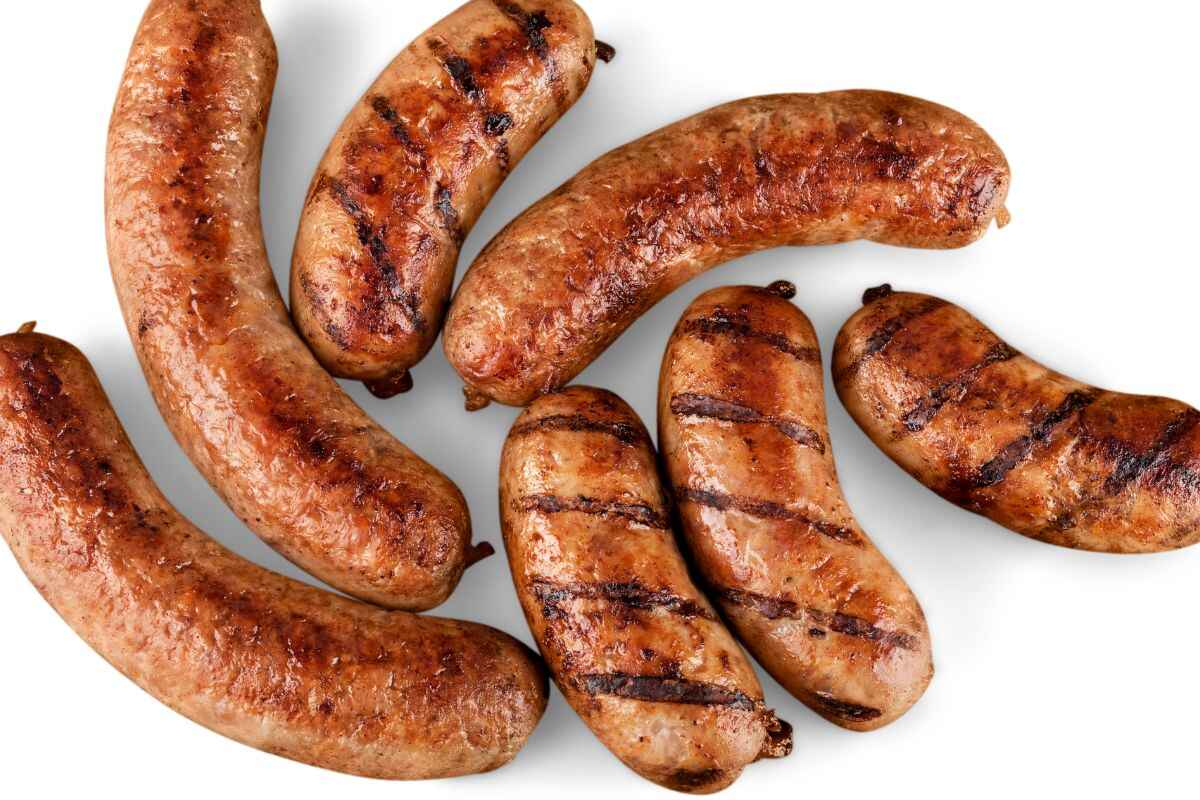Table of Contents
Is Chicken Sausage Healthy?
Chicken sausage is a popular choice for people who want a tasty but lighter option than pork or beef sausages. It is lower in fat and calories, which makes it a great choice for healthier eating. However, you might still ask, is chicken sausage really healthy?
In this guide, we’ll take you through everything step by step. First, we’ll explain the benefits of chicken sausage and why many people see it as a healthier option. Next, we’ll talk about things to watch for, like sodium and preservatives, so you can make better choices. Finally, we’ll share simple tips for cooking and enjoying chicken sausage in balanced, healthy meals.
What Is Chicken Sausage?
Chicken sausage is made mainly from ground chicken and is often a lighter choice compared to pork or beef sausages. It’s seasoned with spices, herbs, and other flavors, making it both tasty and versatile for different meals.
How Chicken Sausage is Made
To make chicken sausage, manufacturers typically grind chicken meat, mix it with spices, and stuff it into casings made from either natural or synthetic materials. The seasoning depends on the flavor being created—some are spicy, while others are mild or smoky.
Why Is Chicken Sausage So Popular?
Chicken sausage has gained popularity because it offers:
- A leaner alternative to pork sausage: Less fat and calories while still being flavorful.
- Versatility: Great for breakfast, lunch, or dinner recipes.
- Dietary adaptability: Options for gluten-free, organic, and low-sodium diets.
Nutritional Breakdown of Chicken Sausage
Chicken sausage is often marketed as a healthier choice compared to pork or beef sausages. Let’s take a closer look at its nutritional value to see if it lives up to the hype.
Calories and Macronutrient Content
The nutritional content of chicken sausage can vary depending on the brand and recipe, but here’s a general idea:
| Nutrient | Chicken Sausage (1 link, ~85g) | Pork Sausage (1 link, ~85g) |
|---|---|---|
| Calories | ~150-180 | ~250-300 |
| Protein | 14-18g | 12-16g |
| Total Fat | 8-12g | 20-25g |
| Saturated Fat | 2-3g | 7-9g |
| Sodium | 400-600mg | 600-800mg |
As you can see, chicken sausage is typically lower in calories and fat while providing a good amount of protein, making it a better choice for those watching their weight or cholesterol levels.
Sodium Content
Chicken sausage is healthier than many other options, but you need to watch its sodium content. Some brands have up to 600mg of sodium per link. This is about 25% of your daily limit. Eating too much sodium can cause health issues like high blood pressure and heart problems. To make chicken sausage a healthy choice, pick low-sodium options. Pair it with fresh vegetables or whole grains for a balanced meal.
Health Benefits of Chicken Sausage
Chicken sausage offers several advantages that make it a popular choice for health-conscious individuals. It’s a versatile protein that fits into many diets while offering key nutrients. Let’s explore its benefits in detail.
1. High Protein Content
Protein is essential because it helps build and repair muscles, supports the immune system, and keeps you feeling full for longer periods. This is why many people ask, is chicken sausage healthy? One of its biggest advantages is its high protein content. For example, chicken sausage typically contains 14-18 grams of protein per serving, depending on the brand, making it an excellent option for various diets and nutritional goals.
For individuals aiming to:
- Build or maintain muscle mass, chicken sausage serves as a convenient and tasty source of high-quality protein.
- Manage their appetite and reduce unnecessary snacking, its protein content helps maintain a feeling of fullness.
- Support a balanced diet, chicken sausage delivers the protein your body needs while being lower in calories and fat compared to traditional sausages.
By incorporating chicken sausage into your meals, you can enjoy a healthy, protein-rich option that supports overall wellness. This makes it a smart addition to your diet when seeking lighter, nutritious alternatives to other types of sausage.
2. Lower in Calories
Compared to pork or beef sausage, chicken sausage typically contains fewer calories, making it ideal for weight-conscious eaters. A standard chicken sausage link has about 150-180 calories, compared to pork sausage, which can contain up to 300 calories per link.
Why this matters:
It helps you manage your calories, making it easier to lose or maintain weight.
It lets you enjoy sausage without consuming too many calories.
3. Reduced Saturated Fat
Saturated fat is linked to higher cholesterol levels and an increased risk of heart disease when consumed in excess. Chicken sausage contains significantly less saturated fat than pork or beef sausage, usually around 2-3 grams per link compared to 7-9 grams.
Heart health benefits:
- Supports healthy cholesterol levels.
- Reduces the risk of heart-related conditions.

4. Versatile and Convenient
Chicken sausage is not only healthy but also easy to incorporate into various meals. But if you’re wondering, is chicken sausage healthy enough for daily use, the answer depends on how it’s prepared and what it’s paired with. Here are some ways to include it in your diet:
- Add chicken sausage to soups and stews for extra protein.
- Use it in pasta dishes as a lighter, flavorful alternative to pork sausage.
- Pair grilled chicken sausage with a side of vegetables and whole grains for a balanced meal.
When considering, is chicken sausage healthy, it’s important to balance it with fresh ingredients and avoid overly processed options.
Healthy cooking tip: Use simple cooking methods like grilling, baking, or sautéing to avoid adding extra calories from oils or butter.
5. Great for Specific Diets
Chicken sausage comes in varieties that cater to different dietary preferences:
- Low-fat options: Perfect for those reducing fat intake.
- Gluten-free options: Available for people with gluten sensitivities.
- Organic or nitrate-free varieties: For those avoiding artificial additives or preservatives.
6. Packed with Nutrients
Aside from protein, chicken sausage provides important nutrients like:
- Iron: Helps with energy and oxygen transport.
- Vitamin B12: Supports nerve function and red blood cell health.
- Selenium: Boosts immunity and protects against cell damage.
Quick Tip: Pair chicken sausage with whole grains (like quinoa or brown rice) and veggies to create a balanced, nutrient-rich meal!
Potential Drawbacks of Chicken Sausage Recipe
Chicken sausage has many benefits, but it’s important to know about its potential downsides. Being aware of these can help you make better choices about how often to eat it and which types to buy.
1. High Sodium Content
One common concern to keep in mind is the high sodium content in chicken sausage. For example, many brands add a significant amount of salt to enhance flavor and extend shelf life. To put it into perspective, a single sausage link can have 400-600 mg of sodium, which is around 20-25% of your daily recommended limit. If you eat more than one link, the sodium intake can add up very quickly, potentially exceeding healthy levels.
2. Preservatives and Additives
When it comes to chicken sausage, one important thing to consider is the presence of preservatives and additives. Many brands use nitrates or nitrites to extend shelf life and maintain color. However, these preservatives can form harmful compounds when cooked at high temperatures, making it essential to choose wisely.
Here’s what to avoid:
- Artificial additives like nitrates, nitrites, or other chemical preservatives.
- Fillers, such as breadcrumbs or starch, which add calories without offering any real nutritional value.
Instead, choose:
- Nitrate-free or all-natural sausages for a healthier option.
- Products with a short, simple ingredient list that includes only recognizable, natural items.
3. Fat Content Varies by Brand
Chicken sausage is generally leaner than pork or beef, but this isn’t always the case. Some brands use dark meat or chicken skin, which can significantly increase the fat content.
To make a healthier choice:
- Always check the nutrition label for the total fat and saturated fat content.
- Look for sausages made with lean chicken meat, as these are lower in fat.
- Avoid fried sausages or those sold in oily packaging, as these are likely to have unnecessary fats and calories.
4. Processed Ingredients
Not all chicken sausages are the same when it comes to quality. For instance, some are highly processed and contain artificial flavors, MSG, or other additives that may not fit into a clean-eating lifestyle. Additionally, these ingredients can detract from the overall health benefits, making it important to choose carefully.
Here’s how to choose better options:
- Pick sausages made with natural spices and real ingredients.
- Stay away from products that list “hydrolyzed protein” or “modified food starch” on the label, as these indicate heavy processing.
5. Watch Your Portions
Even though chicken sausage is healthier than pork or beef, it’s still a processed food. Eating it too often or in large amounts can add unnecessary sodium and fat to your diet.
Final Thoughts
Chicken sausage can definitely be a healthy part of your diet, but it’s important to make smart choices. For example, look for options with lower sodium, fewer preservatives, and leaner meat to maximize the health benefits. Additionally, pairing it with fresh vegetables or whole grains can help create a well-balanced and nutrient-rich meal. By following these simple tips, you can enjoy chicken sausage as a delicious and convenient source of protein that fits seamlessly into your health goals.

Tips for Choosing the Healthiest Chicken Sausage Recipe
Not all chicken sausages are the same! Some are healthier than others, so knowing what to look for can help you make better choices. Here are a few simple tips to pick the best chicken sausage for your diet.
1. Read the Label
The label tells you everything you need to know about what’s inside your chicken sausage. Check for:
- Calories and fat: Choose sausages lower in fat and calories.
- Protein: Look for options with at least 14 grams of protein per link.
- Sodium: Pick sausages with less than 400 mg of sodium per serving if possible.
Pro Tip: The fewer the ingredients, the better! A simple list means fewer additives and fillers.
2. Look for Nitrate-Free Options
Some sausages have nitrates or nitrites, which are preservatives. While these keep sausage fresh longer, they might not be the healthiest choice. Look for labels that say:
- “Nitrate-Free”
- “No Added Preservatives”
- “All Natural Ingredients”
3. Choose Organic or Free-Range
If you’re aiming for a cleaner, healthier, and more natural option, consider choosing chicken sausages labeled as organicor free-range. These products usually come from chickens raised in better conditions, such as without the use of antibiotics, hormones, or harmful chemicals. For many people, this aligns with a focus on sustainability and overall well-being. Organic and free-range sausages also tend to have simpler ingredient lists, free from artificial preservatives, flavors, or fillers, making them ideal for those following a clean-eating lifestyle.
Another advantage of organic and free-range options is the higher quality of the meat itself. The chickens are often fed a more natural diet, which can result in better flavor and nutritional value. Additionally, these sausages often use natural casings and avoid additives like nitrates or nitrites, which are common in more heavily processed products.
By choosing organic or free-range chicken sausage, you’re not only prioritizing your health but also supporting more ethical farming practices. It’s a small change that can have a big impact on your diet and peace of mind.
4. Check for Additives
Avoid sausages with long, complicated ingredient lists. Watch out for words like:
- MSG
- Hydrolyzed protein
- Artificial flavors
Instead, choose sausages made with real, natural seasonings like garlic, pepper, or rosemary.
5. Go for Low-Sodium Varieties
Sodium can add up quickly when you eat sausage. Brands now offer low-sodium options that taste great but contain less salt. Pair these with fresh vegetables or a salad to keep your meal balanced.
6. Watch the Serving Size
It’s easy to eat more sausage than you realize! Stick to 1 or 2 links per meal and fill the rest of your plate with veggies, grains, or fruit to keep it healthy.
Quick Tip: Check the “serving size” on the label. Some brands list a half-sausage as one serving, so the numbers might look lower than they really are!
Tips for Choosing Healthy Chicken Sausage
Choosing the right chicken sausage doesn’t have to be complicated. By following a few simple tips, you can make a healthier choice with ease:
Check the Label: Always start by reading the nutrition label. Look for sausages with fewer calories, less fat, and at least 14g of protein per link to ensure a nutritious option.
Choose Nitrate-Free: For a healthier option, look for sausages labeled as “nitrate-free” or “all-natural.” These options are a better choice because they usually avoid harmful preservatives that can impact your health. By selecting these, you can enjoy a cleaner and more natural product.
Go Organic: If possible, select organic or free-range varieties. These options generally contain fewer additives and come from chickens raised without antibiotics or hormones.
Watch the Salt: Sodium content is another key factor to check. Opt for low-sodium sausages to keep your salt intake under control and maintain a balanced diet.
Keep It Simple: When choosing chicken sausage recipe, focus on finding options made with real, natural ingredients like herbs and spices. For example, sausages with a short ingredient list are often a better choice. On the other hand, it’s a good idea to avoid products that contain artificial flavors or additives such as MSG. By doing so, you can ensure a cleaner and healthier option that fits well into a balanced diet.
Quick Tip: Stick to 1-2 links per meal and pair them with veggies or whole grains!
How to Cook Chicken Susage Recipe
Cooking chicken sausage is easy and delicious!
- Grill It: Cook for 8-10 minutes, turning occasionally.
- Bake It: Place in the oven at 375°F (190°C) for 20-25 minutes.
- Sauté It: Slice and cook in a pan with veggies like peppers or onions.
- Add to Recipes: Use in pasta, soups, or breakfast bowls for extra flavor.
FAQs About Chicken Sausage
1. Is chicken sausage healthier than pork sausage?
Yes! Chicken sausage is lower in fat and calories, making it a lighter option.
2. Can chicken sausage help with weight loss?
Absolutely. It’s high in protein and lower in calories, so it can keep you full without overloading on fat.
3. How to Cook Chicken Sausage Recipe?
You can cook chicken sausage by grilling, baking, or pan-frying. Grill for 8-10 minutes, bake at 375°F (190°C) for 20-25 minutes, or sauté in a pan until browned and cooked through. Always ensure it reaches an internal temperature of 165°F (74°C).
5. Can I eat chicken sausage every day?
It’s okay occasionally, but balance your meals with fresh veggies, fruits, and whole grains.
Conclusion
Chicken sausage Recipe can be a healthy choice if you make smart decisions. It is usually lower in fat and calories than pork sausage, making it good for weight control and heart health. It is also high in protein, which helps build muscles and keeps you full longer. This makes chicken sausage a great option for many meals.
It is also quick and easy to cook, making it perfect for busy days. However, watch out for sodium and preservatives, as these can reduce its health benefits. To make a balanced meal, pair chicken sausage with fresh vegetables or whole grains. With these simple tips, chicken sausage can be a tasty and healthy part of your diet!

